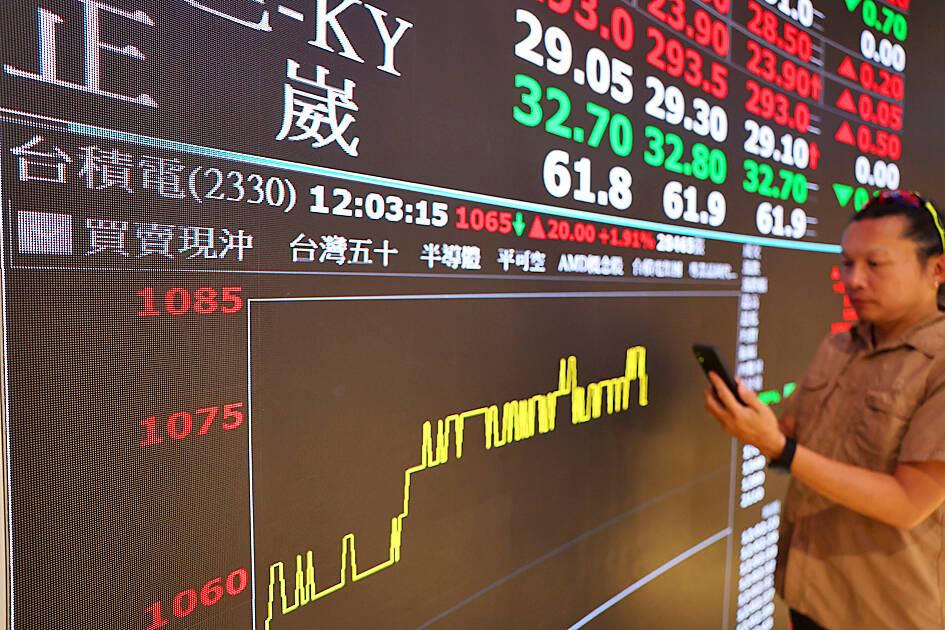The number of major retail investors in the local stock market in the third quarter fell from the previous quarter as Taiwanese shares showed significant fluctuations, data compiled by the Taiwan Stock Exchange (TWSE) showed on Tuesday last week.
A total of 3,519 “big players” participated in the main board in the July-to-September quarter, down from 4,165 in the previous quarter, the data showed.
A “big player” is defined as an investor who trades at least NT$500 million (US$15.59 million) in shares on the TWSE in a single quarter.

Photo: CNA
In addition, the number of “mid-sized players” — or retail investors with a quarterly turnover of between NT$100 million and NT$500 million — also decreased to 32,482 last quarter from 36,284 the previous quarter, TWSE data showed.
The quarterly decreases of 15.51 percent and 10.48 percent in the number of big players and mid-sized players respectively last quarter came as the TAIEX experienced volatile trading — reaching a record high to falling below the 20,000-point mark — with fewer such investors being drawn into local equities.
However, last quarter’s number of big players and medium-sized players is still the second highest in the past 11 and 12 quarters respectively, the data showed.
Meanwhile, the number of retail investors with quarterly trading of less than NT$100 million totaled 5.52 million last quarter, representing a sequential increase of 286,066, the highest-ever increase, TWSE data showed.
Such figures are seen as an important indicator of investor confidence in Taiwanese equities, as the total market turnover on the main board has grown steadily over the past few quarters, with continued optimism in artificial intelligence (AI) development attracting more investors into the market to chase AI-related stocks, the exchange said.
Overall, retail investors accounted for 53.38 percent of the market’s turnover of NT$26.56 trillion in the third quarter, down from 54.88 percent in the second quarter, while foreign institutional investors made up 34.18 percent, up from 33.39 percent. Local institutional investors represented the remaining 12.44 percent, up from 11.73 percent, the data showed.
The TAIEX on Friday closed up 1.88 percent at 23,487.27. The index has risen 30.99 percent since the beginning of the year, with TWSE’s market capitalization rising to NT$75.09 trillion, the first time it has risen above the NT$75 trillion mark in three months, the exchange said.
The TAIEX’s strong showing was mainly driven by Taiwan Semiconductor Manufacturing Co (台積電), which is the most heavily weighted stock on the market and has surged 82.97 percent this year, closing at a record high of NT$1,085 on Friday, exchange data showed.

Intel Corp chief executive officer Lip-Bu Tan (陳立武) is expected to meet with Taiwanese suppliers next month in conjunction with the opening of the Computex Taipei trade show, supply chain sources said on Monday. The visit, the first for Tan to Taiwan since assuming his new post last month, would be aimed at enhancing Intel’s ties with suppliers in Taiwan as he attempts to help turn around the struggling US chipmaker, the sources said. Tan is to hold a banquet to celebrate Intel’s 40-year presence in Taiwan before Computex opens on May 20 and invite dozens of Taiwanese suppliers to exchange views

Application-specific integrated circuit designer Faraday Technology Corp (智原) yesterday said that although revenue this quarter would decline 30 percent from last quarter, it retained its full-year forecast of revenue growth of 100 percent. The company attributed the quarterly drop to a slowdown in customers’ production of chips using Faraday’s advanced packaging technology. The company is still confident about its revenue growth this year, given its strong “design-win” — or the projects it won to help customers design their chips, Faraday president Steve Wang (王國雍) told an online earnings conference. “The design-win this year is better than we expected. We believe we will win

Chizuko Kimura has become the first female sushi chef in the world to win a Michelin star, fulfilling a promise she made to her dying husband to continue his legacy. The 54-year-old Japanese chef regained the Michelin star her late husband, Shunei Kimura, won three years ago for their Sushi Shunei restaurant in Paris. For Shunei Kimura, the star was a dream come true. However, the joy was short-lived. He died from cancer just three months later in June 2022. He was 65. The following year, the restaurant in the heart of Montmartre lost its star rating. Chizuko Kimura insisted that the new star is still down

While China’s leaders use their economic and political might to fight US President Donald Trump’s trade war “to the end,” its army of social media soldiers are embarking on a more humorous campaign online. Trump’s tariff blitz has seen Washington and Beijing impose eye-watering duties on imports from the other, fanning a standoff between the economic superpowers that has sparked global recession fears and sent markets into a tailspin. Trump says his policy is a response to years of being “ripped off” by other countries and aims to bring manufacturing to the US, forcing companies to employ US workers. However, China’s online warriors